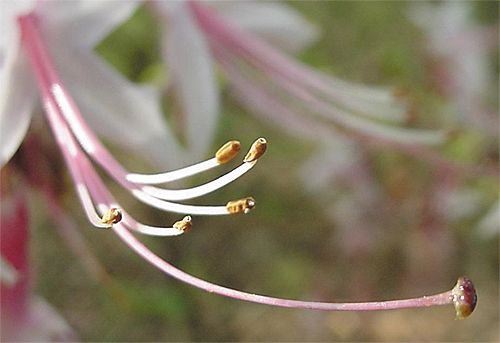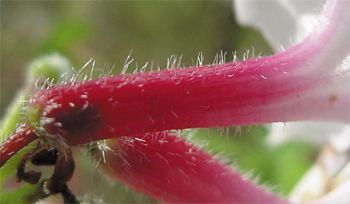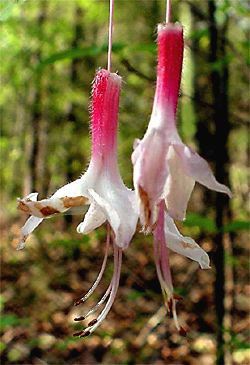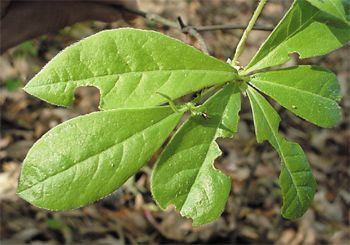|
|
|||
|
THIS WEEK at HILTON POND Back to Preceding Week; on to Next Week |
|
PINXTER-FLOWER For the last few weeks, the Carolina Piedmont has been a riot of color-- primarily because of the vast plantings of ornamentals that do so well in our relatively balmy climate. Perhaps the most popular spring shrubs in these parts are generically called "azaleas," many of which are hybridized from several Asian species by that name. As attractive as these plants might be, in our judgment they are not quite as magnificent as native azaleas--"Pinxter-flowers"--growing wild at Hilton Pond Center. 
All text & photos © Hilton Pond Center We don't wish to belittle the work of horticulturists who have painstakingly interbred numerous azalea species to produce plants that are particularly showy. Nonetheless, there's something very satisfying in knowing that nature has cultivated three nice Pinxter-flowers at the Center without our having to till the soil or fertilize. We're a little amazed these wild pink azaleas are here at all, considering the entire property was in agricultural use for a century or more. Somehow, our three azalea shrubs survived grazing and row crops and lawn mowers, and we're delighted to see them blooming away beneath the tree canopy that now graces much of the Center. Pinxter-flower, with lightly fragrant inch-wide blooms, is perhaps the most common and most familiar wild azalea in the eastern U.S. The name "pinxter" comes not from its coloration but from the Dutch words Pinxter blomachee, which relate to the fact that this is supposedly the azalea that blossoms on Pentecost, 50 days past Easter. We suspect this name was given by folks in northern parts of the plant's range, since in the Carolinas it is more likely to be in bloom for Easter Sunday itself.
Like all azaleas, Pinxter-flower is in the Heath Family (Ericaceae); its scientific name--Rhododendron periclymenoides--reveals it is closely related to some other shrubs that are even bigger and showier. Pinxter-flower was formerly known as R. nudiflorum rather than as R. periclymenoides, which made more sense to us since the plant begins blooming while "nude," i.e. before the leaves appear. Unlike many hybridized azaleas that have relatively short reproductive structures, each wild azalea has an elongated set of five stamens and one really stretched-out pistil (above). These indicate the blossoms are pollinated by insects--especially large-winged, long-legged butterflies such as swallowtails--that hit the long pollen-laden anthers of one flower and then brush past the even longer sticky-tipped style on the next. If, as we suspect, this plant is also visited by Ruby-throated Hummingbirds, R. periclymenoides is often confused with Florida Pinxter- flower, R. canescens. Both occur in the Carolinas but can be separated by the flower tubes, which in R. periclymenoides are fuzzy (above right); R. canescens also has tiny hairs, but they are sticky and glandular. Another noticeable difference is that when a flower of R. periclymenoides dies, a ridge on the corolla tube tends to catch on the end of the pistil so that a flower cluster past its prime consists of several dangling blossoms (below left). (The "dangle phenomenon" also occurs in some of the hybrid azaleas.) Although widespread in the eastern half of the U.S., these two wild azaleas differ in distribution. In South Carolina, for example, R. periclymenoides is a Piedmont plant, Even though these species begin flowering just before the first leaves form, their foliage catches up quickly; by the time the last blooms appear the shrubs typically have their full complement of leaves. Interestingly, foliage on the Pinxter-flowers at Hilton Pond Center already shows heavy predation by leaf-predators (below right); nibble marks on most leaves may be the work of caterpillars of the Azalea Sphinx Moth, On a historical note, Pinxter-flower was discovered in North America by the Rev. John Banister and introduced to England in 1734; Florida Pinxter-flower was first reported in about 1730 by the great naturalist Mark Catesby. Nearly 200 years later, it's nice to know these splendid native species still thrive in the wild--and even co-exist with humans at more domesticated places such as Hilton Pond Center. All text & photos © Hilton Pond Center POSTSCRIPT: For another discussion of this wild azalea, please go to Pinxter-flowers Revisited. Comments or questions about this week's installment? NOTE: Be sure to scroll down for an account of all birds banded or recaptured during the week, as well as some other interesting nature notes. "This Week at Hilton Pond" is written & photographed You may wish to consult our Index of all nature topics covered since February 2000. You can also use the on-line Search Engine at the bottom of this page. For a free, non-fattening, on-line subscription to "This Week at Hilton Pond," just send us an E-mail with SUBSCRIBE in the Subject line. Please be sure to configure your spam filter to accept E-mails from hiltonpond.org. |
|
Make direct donations on-line through
Network for Good: |
|
|
LIKE TO SHOP ON-LINE?
Donate a portion of your purchase price from 500+ top on-line stores via iGive: |
|
|
Use your PayPal account
to make direct donations: |
|


 it could be one of those early spring flowers that our initial wave of hummers relies upon during the first two weeks in April when little else is in bloom.
it could be one of those early spring flowers that our initial wave of hummers relies upon during the first two weeks in April when little else is in bloom. with almost no specimens reported from the Sandhills or Coastal plain, while R. canescens is predominantly a Low Country plant absent from the Piedmont, except in counties that border the Savannah River. In general, if it grows wild north of South Carolina, it's likely R. periclymenoides; south of the Palmetto State and it's probably R. canescens. Both species prefer moist, humus-laden, acidic soil but seem to do equally well in shade or sun. Old specimens can reach heights of 12-15 feet and have multiple stems or trunks up to 5" in diameter.
with almost no specimens reported from the Sandhills or Coastal plain, while R. canescens is predominantly a Low Country plant absent from the Piedmont, except in counties that border the Savannah River. In general, if it grows wild north of South Carolina, it's likely R. periclymenoides; south of the Palmetto State and it's probably R. canescens. Both species prefer moist, humus-laden, acidic soil but seem to do equally well in shade or sun. Old specimens can reach heights of 12-15 feet and have multiple stems or trunks up to 5" in diameter. Darapsa choerilus, but other insect larvae undoubtedly browse on the tender greens.
Darapsa choerilus, but other insect larvae undoubtedly browse on the tender greens.


